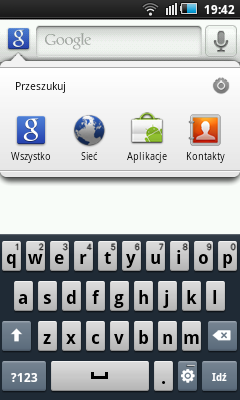 | |
| Manufacturer | Samsung |
|---|---|
| Series | Galaxy |
| Predecessor | Samsung Galaxy Spica |
| Successor | Samsung Galaxy Ace |
| Compatible networks | HSDPA (3G) 900/2100, Quad band GSM / GPRS / EDGE GSM 850, GSM 900, GSM 1800, GSM 1900 |
| Form factor | Slate |
| Dimensions | 113.5×55×12.9 mm (4.47×2.17×0.51 in) |
| Weight | 109 g (4 oz) [1] |
| Operating system | Original: Android 2.1 "Eclair" Current: Android 2.2 "Froyo" |
| CPU | Samsung S5P6422 667 MHz |
| GPU | FIMG 3DSE |
| Memory | 256 MB RAM |
| Storage | 512 MB (170 MB user-accessible) |
| Removable storage | MicroSD support for up to 32 GB |
| Battery | Li-Ion 1500 mAh. Stand-by: Up to 620 h (2G) Up to 510 h (3G) Talk time: Up to 15 h 30 min (2G) Up to 7 h 15 min (3G) |
| Rear camera | 3 Mpix (official spec), autofocus. Video: recording in 3GP (MPEG+AMR-nb); MP4, 3GP playback |
| Display | WQVGA TFT LCD, 3.2 in (82 mm) diagonal. 240 x 400 px, 16 M colors |
| Sound | MP3, AMR, AAC, AAC+, e-AAC+, WMA, WAV, OGG, MID |
| Connectivity | USB 2.0, Bluetooth 3.0, Wi-Fi 802.11 b/g/n, GPS |
| Data inputs | Touch Screen (capacitive) |
| References | [2] |
The Samsung Galaxy 3, also known as the Samsung Galaxy Apollo, Samsung Galaxy Mini in Italy, [3] or Samsung Galaxy 580 in Hong Kong, is a smartphone manufactured by Samsung that runs the open source Android operating system. Announced and released by Samsung in July 2010, [4] the Galaxy 3 succeeds the Samsung Galaxy Spica.
Contents
Being a budget, mid-range smartphone that was designed for the mass market, [5] the Galaxy 3 had several compromises over the Galaxy S in terms of hardware.
It was being the first Samsung Galaxy model to be made and sold in high volumes (unlike Galaxy Spica and i7500, which were not that successful), forcing the rest of the mobile industry to follow suit.
The Galaxy Apollo is a variant of the Galaxy 3 that is also known as the GT-I5800. [6] This was also released as carrier-exclusive sub-variants by Orange (i5801) in the UK, Optimus (i5801) in Portugal and by Telus Mobility (i5800L / Samsung Apollo) in Canada. [2] Compared to the normal Apollo/I5800, the carrier-exclusive models include a different front design, which has touch sensitive buttons instead of physical keys, a more rounded home button, and a slightly different back.
The Samsung Galaxy 3 won bronze of the CNET Asia Reader's Choice Award for Best Entry-Level Smartphone in 2010. [7] [8]
